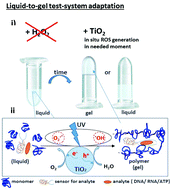Towards sustainable diagnostics: replacing unstable H2O2 by photoactive TiO2 in testing systems for visible and tangible diagnostics for use by blind people
Abstract
Blind and color blind people cannot use colorimetric diagnostics; the problem is especially severe in rural areas where high temperatures and the absence of electricity challenge modern diagnostics. Here we propose to replace the unstable component of a diagnostic test, H2O2, with stable TiO2. Under UV irradiation, TiO2 forms reactive oxygen species that initiate polymerization of acrylamide causing liquid-to-gel transition in an analyte-dependent manner. We demonstrate that specific DNA sequences can be detected using this approach. This development may enable the detection of biological molecules by users with limited resources, for example in developing countries or for travelers in remote areas.

- This article is part of the themed collection: Editors' collection: Physical Chemistry of Colloids and Interfaces


 Please wait while we load your content...
Please wait while we load your content...